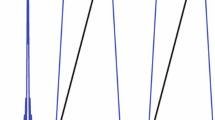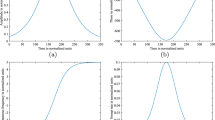Abstract
Frequency-selective inversion of magnetization is often achieved by long, low-power adiabatic RF pulses. Because these pulses can last hundreds of milliseconds, substantial relaxation of magnetization can occur during their application. Recently, a numerical model was introduced that allows an approximation of relaxation during frequency-selective adiabatic pulses for fast-tumbling small molecules in non-viscous solutions using only standard T1 and T2 relaxation times. This model is now extended to conditions in which net magnetization is not at its thermodynamic equilibrium prior to the adiabatic inversion. Simulated and experimental data reveal that the amplitude of net magnetization after an adiabatic inversion with the HS1 hyperbolic secant pulse can be approximated by a linear function of the magnetization before the pulse, depending only on T1 and T2 relaxation. The model presented here is particularly applicable to solvent-suppression sequences that utilize multiple adiabatic inversions, such as the multiple inversion-recovery nulling sequence EXCEPT. Tabulated slope and intercept values for the linear relationship are provided to facilitate a convenient optimization of pulse sequences that utilize HS1 frequency-selective adiabatic inversions.





Similar content being viewed by others
References
M. Garwood, K. Uǧurbil, in: In-Vivo Magnetic Resonance Spectroscopy I: Probeheads and Radiofrequency Pulses Spectrum Analysis. NMR (Basic Principles and Progress) 26, M. Rudin, ed. (Springer, Heidelberg, 1992), pp. 109–147
S. Michaeli, D.J. Sorce, D. Idiyatullin, K. Ugurbil, M. Garwood, J. Magn. Reson. 169(2), 293–299 (2004)
D.J. Sorce, S. Michaeli, M. Garwood, Curr. Anal. Chem. 3(3), 239–251 (2007)
S. Mangia, T. Liimatainen, M. Garwood, S. Michaeli, Magn. Reson. Imag. 27(8), 1074–1087 (2009)
A.R. Pfaff, C.E. McKee, K. Woelk, J. Magn. Reson. 284, 99–103 (2017)
A. Tannus, M. Garwood, NMR Biomed. 10(8), 423–434 (1997)
M. Garwood, L. DelaBarre, J. Magn. Reson. 153(2), 155–177 (2001)
E.T. Satterfield, A.R. Pfaff, W. Zhang, L. Chi, R.E. Gerald 2nd, K. Woelk, J. Magn. Reson. 268, 68–72 (2016)
S. Mani, J. Pauly, S. Conolly, C. Meyer, D. Nishimura, Magn. Reson. Med. 37(6), 898–905 (1997)
W.T. Dixon, M. Sardashti, M. Castillo, G.P. Stomp, Magn. Reson. Med. 18(2), 257–268 (1991)
M.S. Silver, R.I. Joseph, D.I. Hoult, J. Magn. Reson. 59(2), 347–351 (1984)
R. Bro, S. DeJong, J. Chemometr. 11(5), 393–401 (1997)
R.A. De Graaf, Y. Luo, M. Garwood, K. Nicolay, J. Magn. Reson. B. 113(1), 35–45 (1996)
R.A. De Graaf, K. Nicolay, Magn. Reson. Med. 40(5), 690–696 (1998)
Y.A. Tesiram, F. Separovic, Concepts Magn. Reson. 25A(1), 1–17 (2005)
F. Bloch, Phys. Rev. 105(4), 1206–1222 (1957)
Acknowledgements
The work described here did not utilize grant funds from public, commercial, or non-profit organizations.
Author information
Authors and Affiliations
Corresponding author
Rights and permissions
About this article
Cite this article
Pfaff, A.R., Woelk, K. A Fast and Convenient Way to Predict Relaxation During a Frequency-Selective Adiabatic Hyperbolic Secant Pulse (HS1 Sech Pulse). Appl Magn Reson 49, 479–491 (2018). https://doi.org/10.1007/s00723-018-0989-y
Received:
Published:
Issue Date:
DOI: https://doi.org/10.1007/s00723-018-0989-y




